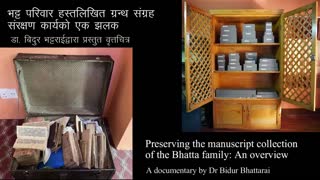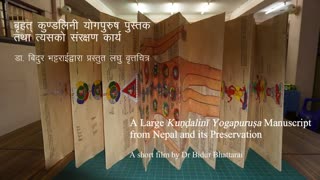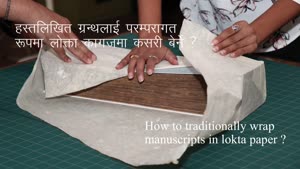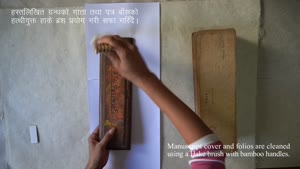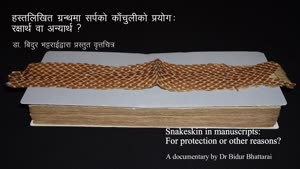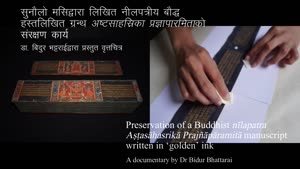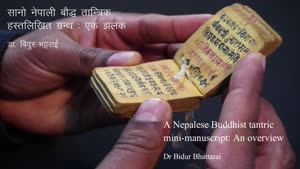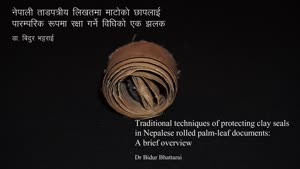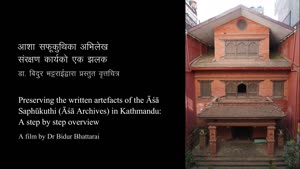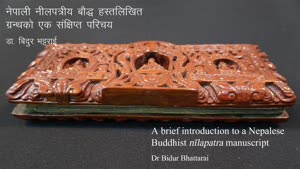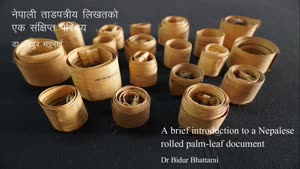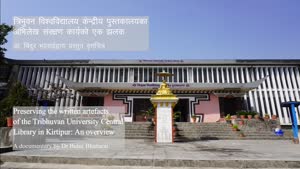Episode 9: Use of Snakeskin in Manuscripts: For Protection or Other Reasons? - Dr. Bidur Bhattarai - Universität Hamburg
- Lecture2Go
- Videokatalog
- F.5 - Geisteswissenschaften
- Centre for the Study of Manuscript Cultures (CSMC)
- Written Artefacts of Nepal – Preservation and Documentation
Videokatalog
2056 Aufrufe
27.11.2023
Centre for the Study of Manuscript Cultures (CSMC)
Cluster of Excellence ‘Understanding Written Artefacts’ (UWA)
Episode 9: Use of Snakeskin in Manuscripts: For Protection or Other Reasons?
When researching or preserving manuscripts, everyone may encounter different kinds of surprising and unique materials. Finding snakeskin in a manuscript, however, is a truly extraordinary occurrence. In this episode of the video series ‘Written Artefacts of Nepal – Preservation and Documentation’, Bidur Bhattarai presents two manuscripts including snakeskin and shows how they are being preserved.
The first example of a manuscript that includes a piece of snakeskin is a copy of the Sārasvatīprakṛyā pertaining to grammar. The text was copied by an individual called Bhājumani (Mr Mani) in Nepālasaṃvat 904 (‘Nepal Era’, corresponding to 1784 CE). The manuscript is written in Sanskrit using Devanāgarī script. The second example is a manuscript containing a copy of the Harivaṃśa. The work is considered to be a supplementary part of the Mahābhārata – one of the two major Sanskrit epics. The manuscript is written in Sanskrit using Newari script and is dated Nepālasaṃvat 835 (1715 CE). Both manuscripts are now being kept and preserved in the Āśā Saphūkuthi (‘Āśā Archives’).
Inserting pieces of snakeskin in manuscripts seems to be a rather rare practice. The reasons for this might be religious or related to tradition. Another possible explanation is that snakeskin is repellent to insects, rodents, and the like – thus, it could also help to preserve the manuscripts. Which explanation is correct remains a matter of scientific investigation.
---
This series of short films offers brief and accessible introduction to Nepalese written artefacts, exploring their diversity and uniqueness in terms of writing, supports, materials, forms, and texts. It is initiated and produced by Dr Bidur Bhattarai, Coordinator of the project ‘Preserving the Written Artefacts of Nepal’ based at the Centre for the Study of Manuscript Cultures at Universität Hamburg. The project is generously supported by the German Foreign Office and the Gerda Henkel Foundation.
---
This series of short films offers brief and accessible introduction to Nepalese written artefacts, exploring their diversity and uniqueness in terms of writing, supports, materials, forms, and texts. It is initiated and produced by Dr Bidur Bhattarai, Coordinator of the project ‘Preserving the Written Artefacts of Nepal’ based at the Centre for the Study of Manuscript Cultures at Universität Hamburg. The project is generously supported by the German Foreign Office and the Gerda Henkel Foundation.
Technischer Support
Bitte klicken Sie auf den nachfolgenden Link und füllen Sie daraufhin die notwendigen Felder aus, um unser Support-Team zu kontaktieren!
Link zu der RRZ-Support-Seite

